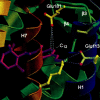Function of extracellular loop 2 in rhodopsin: glutamic acid 181 modulates stability and absorption wavelength of metarhodopsin II
- PMID: 11888278
- PMCID: PMC1404524
- DOI: 10.1021/bi0160011
Function of extracellular loop 2 in rhodopsin: glutamic acid 181 modulates stability and absorption wavelength of metarhodopsin II
Abstract
The second extracellular loop of rhodopsin folds back into the membrane-embedded domain of the receptor to form part of the binding pocket for the 11-cis-retinylidene chromophore. A carboxylic acid side chain from this loop, Glu181, points toward the center of the retinal polyene chain. We studied the role of Glu181 in bovine rhodopsin by characterizing a set of site-directed mutants. Sixteen of the 19 single-site mutants expressed and bound 11-cis-retinal to form pigments. The lambda(max) value of mutant pigment E181Q showed a significant spectral red shift to 508 nm only in the absence of NaCl. Other substitutions did not significantly affect the spectral features of the mutant pigments in the dark. Thus, Glu181 does not contribute significantly to spectral tuning of the ground state of rhodopsin. The most likely interpretation of these data is that Glu181 is protonated and uncharged in the dark state of rhodopsin. The Glu181 mutants displayed significantly increased reactivity toward hydroxylamine in the dark. The mutants formed metarhodopsin II-like photoproducts upon illumination but many of the photoproducts displayed shifted lambda(max) values. In addition, the metarhodopsin II-like photoproducts of the mutant pigments had significant alterations in their decay rates. The increased reactivity of the mutants to hydroxylamine supports the notion that the second extracellular loop prevents solvent access to the chromophore-binding pocket. In addition, Glu181 strongly affects the environment of the retinylidene Schiff base in the active metarhodopsin II photoproduct.
Figures





References
-
- Menon ST, Han M, Sakmar TP. Physiol. Rev. 2001;81:1659–1688. - PubMed
-
- Ballesteros JA, Shi L, Javitch JA. Mol. Pharmacol. 2001;60:1–19. - PubMed
-
- Stryer L. J. Biol. Chem. 1991;266:10711–10714. - PubMed
-
- Palczewski K, Kumasaka T, Hori T, Behnke CA, Motoshima H, Fox BA, Le Trong I, Teller DC, Okada T, Stenkamp RE, Yamamoto M, Miyano M. Science. 2000;289:739–745. - PubMed
-
- Kochendoerfer GG, Lin SW, Sakmar TP, Mathies RA. Trends Biochem. Sci. 1999;24:300–305. - PubMed
Publication types
MeSH terms
Substances
Grants and funding
LinkOut - more resources
Full Text Sources

